Fancy a little crimson color? As it turns out, today is your lucky day! We’ve gathered 15 striking examples of the many bird species that you can find with a splash or more of glorious red color. In the sections below you’ll find woodpeckers, grosbeaks, finches, and many other types of birds that bear a little or a lot of red coloration and we’ve also included information on what they eat and where you can find them.
Types of Red Breasted Birds
Let’s take a at 15 types of beautiful, red-breasted birds!
Cassin’s Finch – Haemorhous cassinii

Coloration and Markings: Cassin’s Finch has a brownish-red back with small wings and tail of the same color, with a white underbelly. The breasts of this bird is white with heavy pink to red streaking and facially, this bird has a small, red crest and a browning-red face, with a white and pink eye line and mustache line that terminates just below the underside of the cheek.
A thin, white eyering is also present and these birds have stout, conical brown bills. Females and juveniles will have basically the same patterning, but they will be brown and white with dark, rather than reddish streaking.
Size: These birds measure in at 6. Inches in length, with wingspans of approximately 9.8 to 10.6 inches wide.
Diet: Up to 90% of the Cassin’s Finch diet is earthworms, though these birds also enjoy centipedes, flies, and the occasional beetle.
More about Cassin’s Finch
Found in mountainous evergreens across North America, these little birds are sometimes found snacking on salt deposits and often in the company of Grosbeaks, Crossbills, and various other types of Finches.
When these little birds aren’t eating worms, they supplement their diet with fruits such as grapes, apples, and firethorn berries and you can also find them snacking on Manzanita and cotton buds in the spring and summer months. It is also interesting to note that if you see a female singing, look again – the first breeding season, a male still has brown and white plumage, leading to the common misconception that the females sing the same songs as the males!
Crimson-Collared Grosbeak – Rhodothraupis celaeno

Coloration and Markings: The Crimson Collared Grosbeak has a black back, with short wings that bear two small, red wingbars, and they have long, black tails. The underbelly and breast of this bird is a sharp crimson color, which carries up at the top into the neck and the apex of the back to make the telltale ‘collar’.
Facially, these birds are black, with a v-shape of color carried down into the breast area. These birds also have small, perky black crests and if you look close you can see a thin, white eyeline. These birds have stout, conical bills which are a mix of gray, white, and black. Females will have the same markings, but their plumage will be olive-colored, rather than the red of the males.
Size: These birds measure in at 8 to 9.25 inches in length and have wingspans of approximately 12.5 inches wide.
Diet: These birds love berries and fruits in general, though they especially like to snack on leaves from potato plants and from the poisonous ‘Deadly Nightshade’.
More about the Crimson-Collared Grosbeak
The Crimson-Collared Grosbeak can be found in the forest and at its edge, as well as areas of dense shrub in northeastern Mexico and southern parts of Texas. First sightings of these birds were in 1974 and as such, we don’t know a lot about this species, aside from that they like to lay their bluish-gray eggs in heavy collections of shrubs and that they are fond of mangoes, Chinaberries, and loquats.
If you see one, be sure to take a picture that you can share and observe for as long as you can… any notes that you can share will be much appreciated by your fellow birders!
Eared Quetzal – Euptilotis neoxenus

Coloration and Markings: The Eared Quetzal, also known as the Eared Trogon, has a shimmery green back with medium-length wings which are iridescent bluish green at the shoulders and mostly black, with grayish outer borders on the wings. They have long, squared, dark-blue tails with light blue highlights and white undersides and the belly and breast of this bird is a striking red, with a v-shape wedge of bluish-green dividing the red at the upper breast.
Facially, these birds are black, and they have stout, lightly curved gray-to-black bills. Females will have more muted coloration, tending to grays rather than blacks and with duller plumage.
Size: These birds measure in at 13 to 14 inches long and have a wingspan of roughly 24 inches when fully grown.
Diet: Eared Quetzals like to eat bush crickets, moths, caterpillars, and these little omivorves are also fond of fruits, particularly the warty fruit if the Madrone tree.
More about the Eared Quetzal
Once found only in Mexico, the Eared Quetzal has been on the move and is now spotted sometimes in Arizona and New Mexico as well. They seem to like canyons, especially those close to water, but don’t look for flocks – aside from breeding season, these birds tend to be colorful loners. In the woods, these lovely birds are fond of stealing woodpecker holes!
Breeding season for the Eared Quetzal is from March to as late as October, so if you are lucky enough to see one courting a female, then you are in for a treat. Males like to fly straight up, often performing aerial stunts before flying sharply down and singing as they go!
Elegant Trogon – Trogon elegans

Coloration and Markings: The Elegant Trogon is quite the colorful bird, with a copper-green back with short, gray wings with some black and white at the center edges and long, olive and gray tails that have striking black and white striping and barring on the underside. The belly and breast are a rosy red with a white swath at the top, followed by a green collar with a black throat and head.
They have a distinctive yellowy-red eyering as well as a stout, medium length yellow bill which is lightly curved. Females and juveniles have a grayish-brown, rather than black coloration, and a white teardrop marking is also present on the face.
Size: These birds have a length of approximately 11 to 12 inches and wingspans reaching up to 16 inches wide.
Diet: These birds prefer live food, munching happily on katydids, caterpillars, walking sticks, and the occasion surprised lizards.
More about the Elegant Trogon
Elegant Trogons are considered quite the prized sighting and you can only see them in Southeastern Arizona, unless you happen to be visiting Guatemala or Mexico. In Arizona, there birds like Oak and Pine forests but they have a lot of habitats, such as lowlands, floodplains, and especially coniferous forests where they may be found.
They don’t ‘talk’ a lot, often standing solemnly when spotted, although they are known to emit the occasional ‘kwah’ from time to time and while they prefer live food, fruits and berries will certainly do in a pinch. Interestingly enough, these birds can turn their heads the same way that owls can, so if you spot one and get lucky you might get to see a demonstration of that 360 degree range that makes you think of the ‘Exorcist’ movie. With any luck, you’ll go home with some nice pics and videos to share of this colorful, lovely species!
Hepatic Tanager – Piranga flava

Coloration and Markings: The Hepatic Tanager has a red back interspersed with grays, as well as long gray and red wings and a medium-length red tail with a grayish tip. The underbelly and breast of this bird are a lovely, almost orange-red which brightens considerably on the mostly-red head of this Tanager.
At the eyes, there is a broad strip of gray going back to the cheek, with a little gray at the top and back of the head, and these birds have a thick, lightly curved gray bill. Females and juveniles will be yellowish-olive on top, and buff below.
Size: These birds can be as tiny as 3.5 inches or as big as 7.9 inches in length, with wingspans of approximately 12.6 inches in width.
Diet: While they supplement their diets with the occasional berries, Hepatic Tanagers prefer spiders and insects that they can find and pluck-up in the trees.
More about the Hepatic Tanager
Found in North, South, and Central America, Hepatic Tanagers are sometimes spotted in Arizona and New Mexico and they are quite fond of pine and oak woodlands, when they can find them. The name ‘Hepatic’ refers to their reddish-brown color, much like a liver, and from mid-May to June you can catch the males a-courting.
This display is not aerial, like with some birds, but rather seen in the trees where a male will spready out his wings to show off his colorful back. After breeding season, listen for calls going back and forth, as the new parents will sing back and forth with their chicks!
House Finch – Haemorhous mexicanus
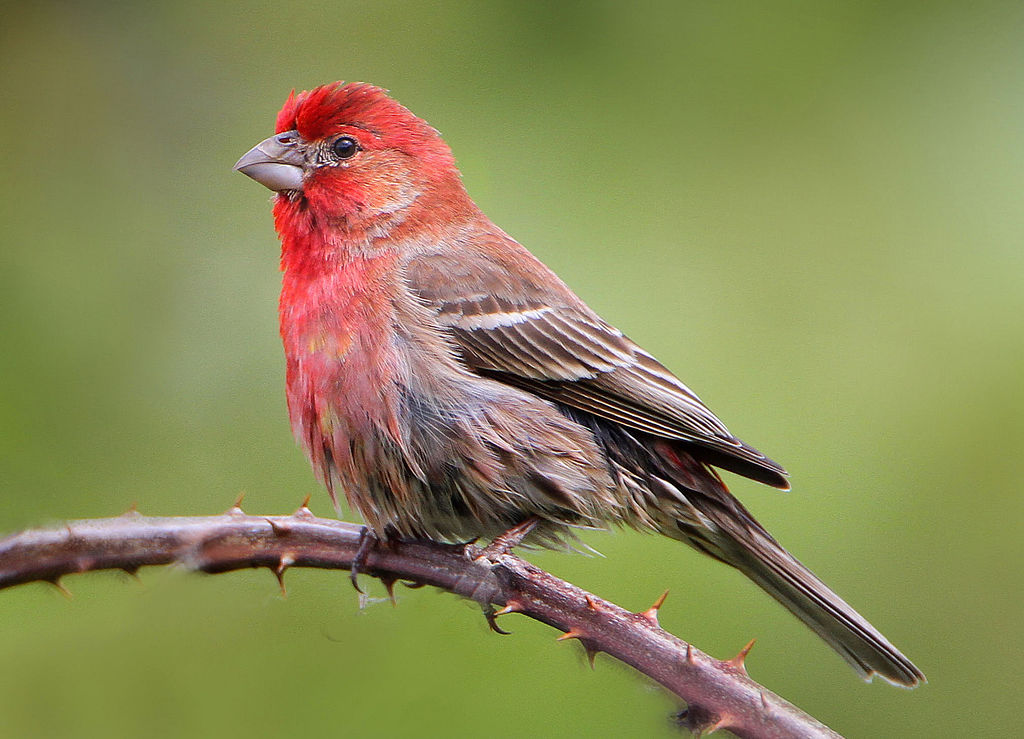
Coloration and Markings: The adorable little House Finch has a streaked back that is brown or black and white, with short wings of the same color that sport two white wingbars. They have short, lightly notched tails which are also streaked on top and a smooth white and gray below. The underbelly of this bird is white, which rosy-red streaking the thickens up at the breast, and facially this bird is mostly red – with gray around the cheek and eyes, as well as a little on the back of the head and the crown.
Females will have the same marking but lack the red color and their streaks will be a bit more blurry. These birds have thick, conical gray bills.
Size: These little birds measure in at 5.1 to 5.5 inches in length and have wingspans of 7.9 to 9.8 inches wide.
Diet: These birds eat seeds that are found in the weeds, as well as buds and other parts of flower, and any small fruits that they can find. Seeds from these fruits are fed to their young and they also eat the occasional insect when they find them.
More about the House Finch
Found in Mexico, as well as the eastern United States and the state of Hawaii, House Finches are comfortable in both backyard and forest environs, and these bouncy little birds are more than happy to visit your feeder.
Interestingly enough, there are about 11 subspecies of this bird, so coloration may vary a bit based on where you see them. Not only that, they have their own ‘accents’, with song variations occurring commonly in different regions!
Northern Cardinal – Cardinalis cardinalis
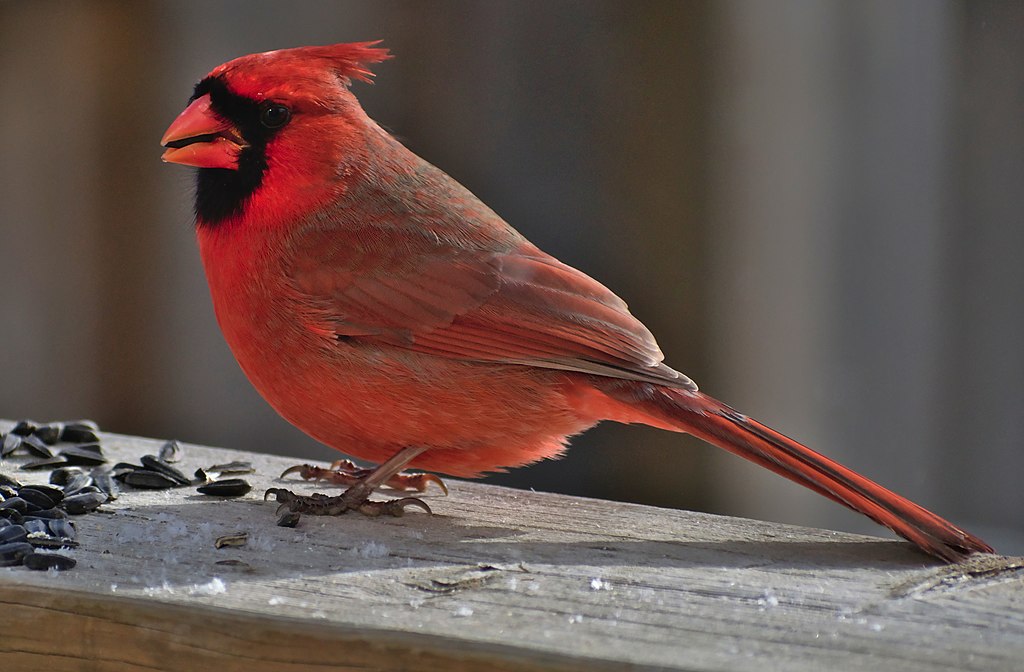
Coloration and Markings: A longtime favorite for many birders, the Northern Cardinal has a crimson back, with short, red wings tinged with brown and long tails of the same color. The underbelly and breast of this bird are red, as well, while facially the Cardinal is red with a black half-mask that continues down under the bill and onto the throat.
Northern Cardinals have a lovely, large crest and stout, conical red bills. Females will be light brown in color, with touches of red in their crests, wings, and tails.
Size: These birds measure in at 8.3 to 9.1 inches and have wingspans of approximately 9.8 to 12.2 inches wide.
Diet: Northern Cardinals eat many different insects, such as flies, beetles, and centipedes, though they will also eat small fruits, flower buds, waste grains, and other fruit and vegetable matter.
More about the Northern Cardinal
The Northern Cardinal is found in Mexico, Central America, and throughout the Eastern United States. These striking birds, believe it or not, get a lot of that red coloration from the foods that they eat. Chemicals known as carotenoids exist in certain foods and they help to produce that amazing red pigment, enough to the point that if a male Cardinal doesn’t get them, you’ll see the bird slowly begin turning brown!
These crimson wonders mate for life and on a fun note, they also go bald from time to time! You can see this in the late summer and if you do, don’t worry – it’ll grow back, you’ve just caught the Cardinal during a seasonal molting.
Painted Bunting – Passerina ciris

Size: The Painted Bunting is a dazzling display of color, with a yellow-green back, medium-length yellow green wings that are dark around the wingtips and inner wing, with a line of blue and red streaking down towards the outer shoulder. The lower back and tail are actually red, with dark brown or black present on the long tail and the underbelly and breast of this bird are red, as well.
Facially, the bird is a striking blue, which carries down the neck and across the tops of the shoulders, and a bright reddish-orange eyering completes your identifying traits. Females and juveniles are similar, though expect mostly yellowish-green and much less vibrant eyerings.
Diet: These birds are primarily granivores meaning that they live mostly on a diet of seeds and grains. White proso millet also happens to be one of their favorite types. Hint, hint! That said, they do occasionally munch on flies, worms, and even spiders – often stealing trapped flies and other insects from their webs!
More about the Painted Bunting
If you are looking for the Painting Bunting, then you’ll find these birds in 2 North American separate regions – the first being from North Carolina to Central Florida and the second in across the South-Central United States. They are also found in Mexico, the Bahamas, and Cuba!
These vibrantly colored birds are a treat to watch during mating season, then the males will puff out their chests and show off their feathers to a female that they won’t mater for life with… though perhaps for the entirety of that particular breeding season.
Painted Redstart – Myioborus pictus

Coloration and Markings: Painted Redstarts have black backs with short, black wings, each of which sports a large, white wing patch. Their long, black tails are white on the undersides and this white carries up into the underbelly of the bird, before turning into a vibrant red color that carries from the belly to the top of the breast. This coloration is flanked with black at the side.
Facially, this bird is black, with a curved white underline marked under each eye, and these birds have thin, lightly curved bill. Juveniles will be gray, rather than red, at the breast and upper portions of the belly.
Size: These birds measure in at 5.1 to 5.9 inches in length and have wingspans of approximately 8.3 inches wide.
Diet: While they will eat the occasional seeds and berries, the bulk of a Painted Redstarts diet is made up of various insects, such as crane flies, leafhoppers, caterpillars, and moths. They also raid the occasional Hummingbird feeder for sugar water, as they have a bit of a sweet tooth.
More about the Painted Redstart
The Painted Redstart may be found in Mexico and Central America, although you can also find them in the southwestern states of Arizona, New Mexico, and the Lone Star State of Texas. Of note, males and females sing at equal skill, which is quite uncommon in birds, and you’ll probably hear that song before you spot the actual bird.
Despite those amazing colors, the Painted Redstart is somehow a wee bit of a sneak!
Pine Grosbeak – Pinicola enucleator

Coloration and Markings: Pine Grosbeaks have red backs with gray highlights, as well as small wings which are gray at the shoulders and darker gray below, with 2 prominent white wingbars present. They have long, gray tails with a slight notch at this tip and facially, these birds are red with hints of gray, as well as a diamond gray mask. These birds have stout, lightly curved gray to black bills.
Size: These Grosbeaks measure I at 7.9 to 9.8inches in length, with wingspans approximately 13 inches wide.
Diet: Maple tree buds, conifer seeds, berries, and the occasional insects make up the diet of the Pine Grosbeak – with bugs being the preferred summer fair, while fruits, seeds, and veggies make up most of its winter diet.
More about the Pine Grosbeak
Pine Grosbeaks love coniferous woods and you can find them in Canada as well as in the northwestern and western United States. These elusive little beauties are noted to have graced the design of the Canadian $1000 bill in 1986 and while ‘Pine’ is in their common name, it’s also hidden in the genus name – Pinicola is just latin for ‘Pine Dweller’!
Purple Finch – Haemorhous purpureus
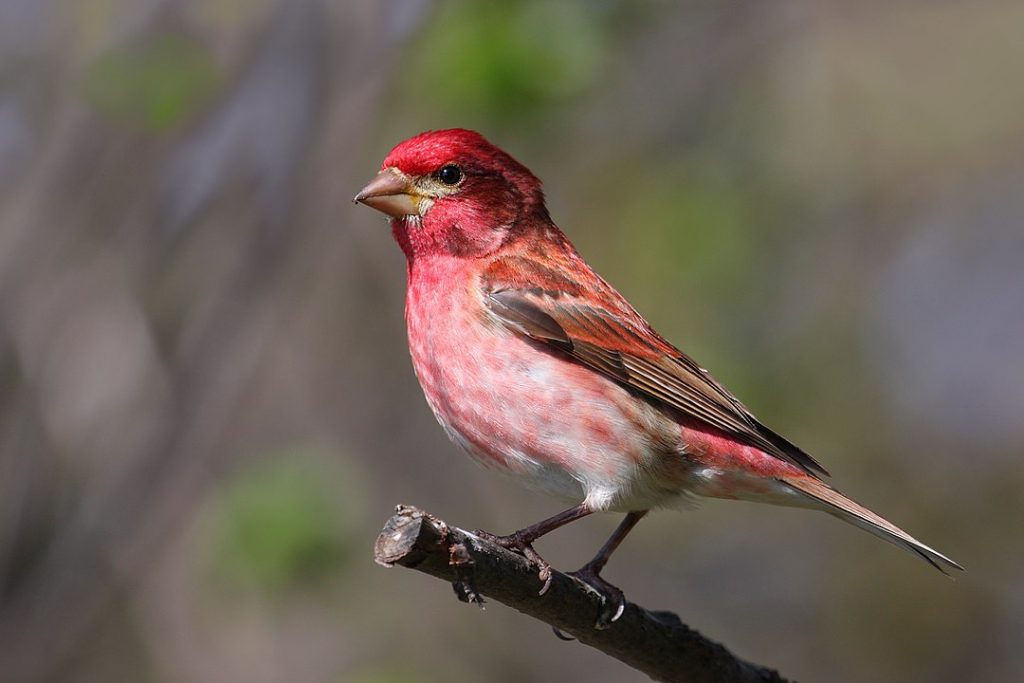
Coloration and Markings: Purple Finches have pinkish-red and brown backs, with medium-length wings of the same color, which sport a thin, pink and white wingbar each. They have perky, medium-length pinkish-brown tails with white on the edges and white underbellies. Starting at the underbelly is pinkish-red streaking, which increases in volume as the coloration moves up the breast.
Facially, these birds have dark red faces, with pinkish eyelines and mustache lines which terminate, respectively, at the back of the head and below the cheek. These birds have stout, conical yellow bills often with a touch of black. Females will be more of an olive color, with a white eyestripe and dark marking at the throat.
Size: These little birds measure 4.7 to 6.3 inches in length and have wingspans ranging from 8.7 to 10.2 inches wide.
Diet: In the winter, Purple Finches feed almost primarily on seeds from the weeds, grass, and also from Ash and Elm trees. Once it warms up outside, fruits and berries are also on the menu, as well as caterpillars, flies, and beetles.
More about the Purple Finch
Purple Finches may be found on the Pacific Coast, as well as in Canada, and in the eastern United States. They are fond of both deciduous and coniferous woodlands and these little birds are quite the socialites, often foraging and roosting among American Goldfinches and Pine Siskins – though there is a pecking order. Purple Finches can easily boss around Goldfinches, but they mind their ‘p’s and q’s’ around the Pine Siskins.
Pyrrhuloxia – Cardinalis sinuatus
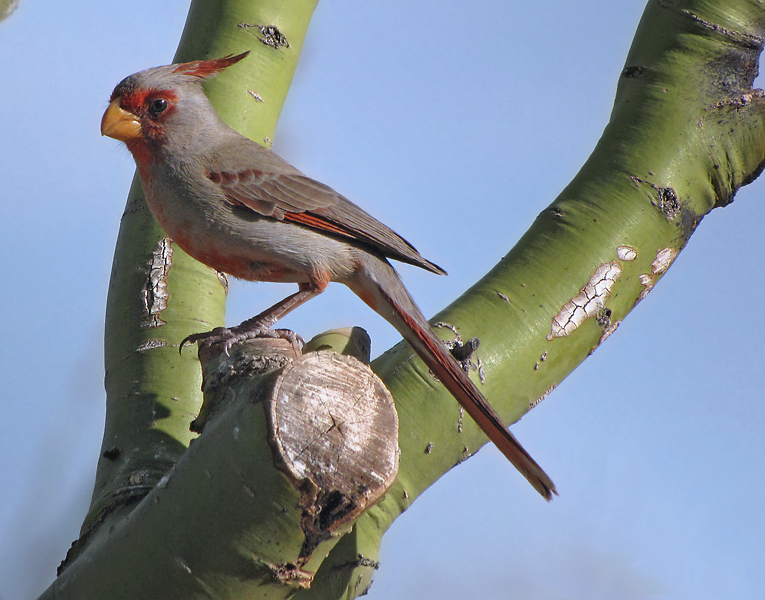
Coloration and Markings: Pyrrhuloxias, with their large crests and splashes of red, look rather like yellow-billed Cardinals that have been rolled in ash. They have gray backs, with medium-length gray wings with red towards the outer sides, and long, gray tails which are red on the undersides and have gray splotches towards the tips. These birds also have white rumps and deep red belly and breast, with a heavy flanking of gray towards the top of the chest.
Facially, these birds have gray heads, but deep red at the eyes, the throat, and the very tips of their majestic crests. These birds have large, short yellow bills and females will be more of a buffy gray than red.
Size: These birds measures in at approximately 8.3 inches from tip to tail and have wingspans averaging about 12 inches wide.
Diet: Cactus fruits, berries, and seeds are a big part of the Pyrrhuloxia’s diet and it also eats a lot of insects when it can, such as caterpillars, beetles, grasshoppers, and more.
More about the Pyrrhuloxia
Discovered in 1838 by one of Napoleon’s Nephews (one Charles Lucian Bonaparte), the Pyrrhuloxia may be found in the southwestern states of New Mexico, Arizona, and Texas, leading some to believe that this bird should be known as the ‘Desert Cardinal’. Look for these birds around desert scrub and in the winter they’ll be much easier to spot ,travelling in flocks of up to 1000 birds at a time!
These birds are also quite territorial about their own areas, though with their own species defense seems to be done more for show, rather than devolving into actual fighting.
Red Crossbill – Loxia curvirostra

Coloration and Markings: Red Crossbills have brisk-red backs, with medium-length gray wings that show a little red at the shoulders and thin traces of white outline. They have short, notches tails which are dark, with white edging, and faint splashes of read and the underbelly and breast of this bird are the same brick red as their backs – with tiny spots of white visible when seen up close.
Facially, these birds have red heads with gray eyelines which trace back and curve around towards the cheek and they also have odd bills, which are curved and gray and overlap and cross a bit when fully closed. Females are colored differently, being yellowish or olive colored with flecks of brown or gray all over.
Size: These birds measure in at 5.5 to 7.5 inches in length, with wingspans approaching 10 to 11 inches wide.
Diet: Red Crossbills eat mostly seeds, though they also dine on berries, flower buds, and the occasional caterpillar or other small insects caught during breeding season.
More about the Red Crossbill
Found in Mexico and across the United States, Red Crossbills are quite the interesting birds. Take those crooked bills, for instance. Until the birds are about 4 to 5 weeks, their bills are actually straight, but they get ‘crossed’ and it serves a definite purpose – breaking up pinecones. In fact, they eat so many conifer seeds, that these seeds are also the most common ‘baby food’ for hungry chicks!
Look for them in coniferous or evergreen forests and they also visit the occasional park and backyard feeder.
Red-Breasted Nuthatch – Sitta canadensis
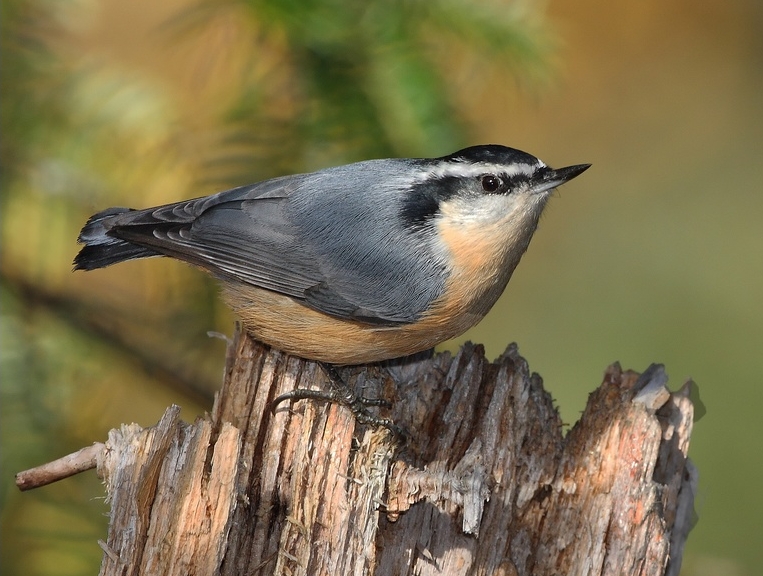
Coloration and Markings: Red-Breasted Nuthatches are adorable little guys and gals, with bluish-gray backs and short bluish-gray wings that have darker gray outer edges and tips. They also sport small, bluish=gray tails which are white on the undersides.
The underbelly and breast of this bird are a cinnamon-rust color and facially, they have white faces with a long black bandit-mask and a small black cap. These birds have thin, sharp, and medium length black bills and females will look much the same, albeit with a duller rusty-cinnamon coloration.
Size: These tiny birds average around 4.3 inches in length and have wingspans ranging from 7.1 up to 7.9 inches wide.
Diet: Red-Breasted Nuthatches eat a lot of seeds, especially conifer, and they also enjoy the occasional spider and other insects as well.
More about the Red-Breasted Nuthatch
These little lovelies may be found in Mexico or in the United States, specifically in Idaho, Washington, the California coast, and in western Montana. The name ‘Nuthatch’ comes from a cute and practical habit of these birds, who are often spotted wedging small nuts into tree bark to store for later consumption.
These birds also install a little security (or perhaps a food trap, we aren’t certain) on the holes in their homes in the form of conifer resin applied around the edges. Just in case you were wondering what to call a group of these birds, Red-Breasted Nuthatches travelling in numbers are referred to as a ‘jar of Nuthatches’. It sounds a little strange, but it’s true!
Red-Breasted Sapsucker – Sphyrapicus ruber

Coloration and Markings: Red-Breasted Sapsuckers are a type of woodpecker that has a black, white-spotted back, with medium-length black wings and a long, notched black tail. This tail is black and white on the underside and the belly and breast of this bird are mostly white with spots od black, except at the top of the breast where you will see a deep and rich red that comes down from the face and the throat in a v-formation.
Facially, these birds have red heads and distinctive white lines at the very back of the bill, in front of the eyes. Like all woodpeckers, these Sapsuckers have long, thin black bills.
Size: These birds measure 7.9 to 8.7 inches from tip to tail and have wingspans of 14.6 to 16 inches wide.
Diet: As the name suggests, these birds love sweet sap and this also gets them an appreciable amount of ants and other insects. They also like berries, fruits, and nuts when available.
More about the Red-Breasted Sapsucker
Red-Breasted Sapsuckers are found on the Pacific Coast and also range from Alaska to British Columbia. They like pine and deciduous woodlands, making their nests in rotted tree hollows, and it’s a cute little fact that you might not know, but hummingbirds often make use of Sapsucker holes that have been vacated, hiding inside safely until the flowers begin to bloom!
Some Final Words
That’s all of the space that we have for today and we hope you’ve enjoyed this little foray into the world of red-breasted birds. While we’ve only covered 15 of our favorites, keep an eye out – there are quite a few species that bear this coloration and you certainly don’t want to miss them.
Keep your eyes peeled and your camera ready, plus a pocketful of seed never hurts, and with a little luck you might just have some pictures to share with the rest of us. Until next time, happy birding, folks!
